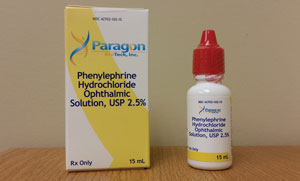 |
Q: Why are the prices of phenylephrine and proparacaine skyrocketing, and what alternatives are available?
A: The number one factor influencing this rise in cost is the shortage of phenylephrine, explains Jill Autry, OD, RPh, who practices at the Eye Center of Texas. Phenylephrine is most commonly used for its sympathomimetic effect to dilate the pupil before eye examinations or surgery, and is a vasoconstrictor that can ameliorate ocular injection. “Over the past two years, in the generic market, companies that were making phenylephrine have stopped,” she says. She notes three manufacturers are having issues with production, while the remaining manufacturers of phenylephrine have increased their prices significantly, which has providers scrambling for alternative dilation medications. Prices for proparacaine, the topical anesthetic, have also risen, though not as significantly as phenylephrine.
Dr. Autry notes the manufacturing shortage for both solutions is likely due to a narrow profit margin for production, which impacts the amount of ophthalmic solution produced. “Since these drops have a shorter shelf life, the manufacturers don’t make a whole bunch of it,” she says. “There’s a lot more stringency on ophthalmic products—anything in glass bottles, IV medications, anything where the sterility is more of a concern than [it would be with] a pill.”
 | |
| A manufacturing shortage means that generic phenylephrine prices are rising. What other options do practitioners have? |
Typically, she explains, if something at the manufacturing plant temporarily impedes production, the company could simply rely on a stockpile of pills for up to several weeks, since pills have a longer shelf life. This is not the case, however, with ophthalmic solutions. Instead, the supply simply runs out until the manufacturing plant can be brought back online.
Dr. Autry suggests substituting tetracaine, another ophthalmic numbing drop, as a lower-cost alternative for proparacaine. On the phenylephrine side, tropicamide is a good choice, though it dilates through the parasympathetic system instead of the sympathetic system. “We use both [phenylephrine and tropicamide], on the patients that need to be dilated over a longer time period, especially for retinal exams,” Dr. Autry says. She notes that phenylephrine should be used in addition to tropicamide in patients who are hard to dilate, like those with diabetes or who are on benign prostatic hyperplasia (BPH) medications. Paremyd (hydroxyamphetamine hydrobromide 1% and tropicamide ophthalmic solution 0.25%, Akorn) is also a good substitution for phenylephrine, though the combination may be weaker than single-component formulas, Dr. Autry says.
Until pricing for phenylephrine and proparacaine drastically change, Dr. Autry recommends the use of phenylephrine on a case-by-case basis. “What we’re going to start doing now in our offices is dilating our non-retinal patients with just tropicamide. If we find the dilations are not adequate, then we’ll add the phenylephrine,” she says. “That way, we won’t go through as much of the pricey drops, keeping overhead a bit lower.”
